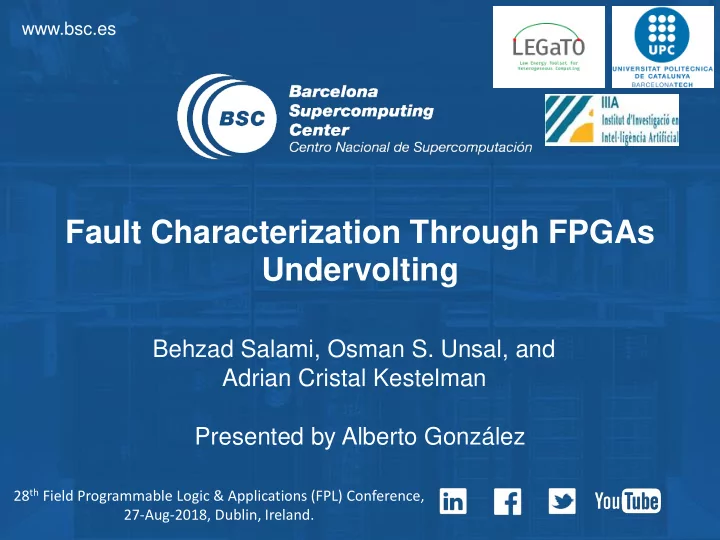

www.bsc.es Fault Characterization Through FPGAs Undervolting Behzad Salami, Osman S. Unsal, and Adrian Cristal Kestelman Presented by Alberto González 28 th Field Programmable Logic & Applications (FPL) Conference, 27-Aug-2018, Dublin, Ireland.
Undervolting Underscaling the supply voltage below the nominal level : • Power/Energy Efficiency : Reduces quadratic ally dynamic and linearly static power. • Reliability : Increases the circuit delay and in turn, causes timing faults. Power/Energy Reliability Efficiency Aggressive Undervolting is not DVFS! 2
Motivation Contribution of FPGAs in large data centers is growing, expected to be in 30% of datacenter servers by 2020 (Top500 news). Our Aim: • In comparison to ASICs, Undervolting FPGAs below the nominal energy efficiency of FPGAs is level to achieve energy efficiency. a serious concern. • Nominal voltage reduction Subsequent Study: of FPGAs is naturally applied Undervolting How is the reliability affected through for different generations. FPGAs Undervolting? 3
Voltage Scaling Capability in Xilinx Voltage Distribution on Xilinx Platforms Evaluated Xilinx Platforms VC707 VC707 : performance-efficient design KC705 : power-efficient design Voltage Regulator • Power Management Bus (PMBus). • Hardwired to the host. 4
Experimental Methodology A Detailed study on FPGA BRAMs, which are a set of bitcells in the row-column format. A B Experimental Methodology: 1. HW : Transfer content of BRAMs to the host. 2. SW : Analyze data, and adjust Floorplan of VC707 voltage of BRAMs. Operating frequency is set to the maximum, i.e., ~500mhz. HW SW B 5
Overall Behavior- Power & Reliability • No observable fault SAFE • Voltage Guardband Below Vnom • Faults manifest CRITICAL • Below Vmin, min safe voltage Voltage Guardband: • FPGA stops operating below CRASH Vcrash, min operating voltage 1- DRAM - MultipleVendors [Sigmetrics2017]:16% VC707 vs. KC705 1. Vnom= 1V. 2- GPU - NVidia [Micro2015]: 20% 2. Vmin & Vcrash are 3- CPU - ItaniumII [ISCA2013]: 12% slightly different. 3. More than 10X energy 4- FPGA - Xilinx [our work- FPL2018]: 39% efficiency. 4. Exponential fault rate increase. 5. VC707 experiences relatively more fault rate. VC707 6 KC705
Fault Characterization at CRITICAL Region Fault Variability between BRAMs • BRAMs clustering using K-Mean clustering. • Majority of BRAMs VC707 are low-vulnerable. • ~36% of BRAMs never experience faults. KC705 • Fully non-uniform VCCBRAM= Vcrash fault * Different scales in y- axis * *Pattern= 18’h3FFFF * distribution. 7
Thanks! 8
www.bsc.es Contact: Behzad Salami behzad.salami@bsc.es
Backup 10
Outline • Background – What does Undervolting mean? – Motivation: FPGAs Undervolting • First Contribution: Undervolting Xilinx FPGAs • Experimental Methodology • Overall Power and Reliability Trade-off • Second Contribution: Fault Characterization • Fault Variability • Fault Types • Impact of the Environmental Temperature • Related Work • Summary and Future Works 11
Fault Characterization at CRITICAL Region Permanent ‘1’ to ‘0’ bit -flips Permanent: ‘1’ to ‘0’ bit flips: • • There is no considerable change on the Experimentally proved that majority of rate and location of faults over time. Conclusion: faults are ‘1’ to ‘0’ bit-flips. • Validated by repeating experiments for • No matter for ‘0’ and ‘1’ permutations . 100 times. Permanent ‘1’ to ‘0’ bit -flips can be VC707 translated as stuck-at-0 , at a certain VC707 voltage, temperature, etc. KC705 12
Related Works of Undervolting • Simulation-based : (Lack of precise information of the real hardware.) – Thundervolt: ASIC-based DNN (DAC2018 ) Focus of Previous Works: – Minerva: ASIC-based DNN (Micro2016) (1) Covered in our work for FPGAs – Bravo: CPU (HPCA2017 ) • Voltage Guardband • Real Commercial/Customized Devices : (Needs • Fault Characterization at Critical Region experimental efforts.) – CPUs: Itanium II (ISCA2013), X86 (IOLTS2017) • Impact of Environmental Conditions – Multicore CPU: ARM (HPCA2017, ISPASS2018) (2) Not-covered in our work on FPGAs (Future Work) – GPUs: NVidia (Micro2015) • Dynamic Vmin Prediction – DRAMs: Multiple Brands (Sigmetrics2017) • Fault Mitigation at Critical Region – SRAMs: Customized (ISQED2017) • Application Profiling – FPGAs: Xilinx (Our Work- FPL2018) 13
Constraints of Xilinx FPGAs Future of FPGA Undervolting needs more advanced voltage designs, by vendors: 1. Many FPGA platforms, e.g., Zynq are not equipped with voltage scaling capability. 2. There is no standard about the voltage distribution among platform components. 3. Voltage regulators are hardwired to the host through PMBus interface. 4. In many cases, several components on the FPGA platform share a single voltage rail. 5. Vendors set unnecessarily conservative voltage guardbands that increase the energy. 6. There is no publicly-available circuit-level information of FPGAs. 14
Fault Characterization at CRITICAL Region Environmental Temperature Methodology: Adjusting environmental temperature, monitoring on-board temperature via PMBus. Experimental Observation: At higher temperatures, fault rate is significantly reduced. The rate of this reduction is highly platform-dependent (VC707 > KC705). Inverse Temperature Dependency (ITD): For nano-scale technologies, under ultra low-voltage operations, the circuit delay reduces at higher temperatures since supply voltage approaches the threshold voltage. 𝑈 = 50 0 𝐷 𝑈 = 60 0 𝐷 𝑈 = 70 0 𝐷 𝑈 = 80 0 𝐷 * y-axis: VCCBRAM (V), y-axis: fault rate (per 1Mbit) * 15
Summary & Future Works Summary Future Works • We experimentally showed how • Dynamic Vmin scaling, adapted Xilinx FPGAs work under by frequency and temperature. • aggressive low-voltage More advanced designs, where operations. other components such as I/O, • There is a conservative voltage DDR, DSP are undervolted. • guardband below the nominal Efficient Fault Mitigation level. Techniques. • BRAMs power is significantly • Profiling applications such as reduced through Undervolting; Deep Neural Networks (DNNs), however, reliability degrades among others. • below min safe voltage. Extending Undervolting for • We characterized the behavior of other commercial FPGAs such Undervolting faults at the critical as Intel/Altera. region. 16
Recommend
More recommend